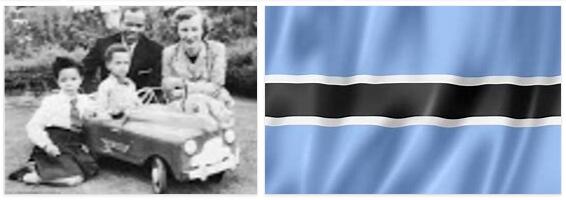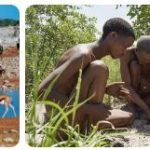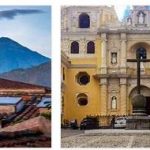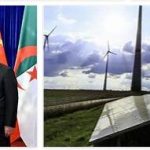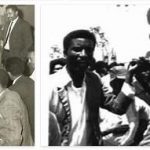According to ezinereligion, the Republic of Botswana is a state in southern Africa. The country has no access to the sea. Botswana was formerly the British protectorate of Bechuanaland, and Botswana took its new name after the independence of the Commonwealth on September 30, 1966. To the south, Botswana borders South Africa, to the west to Namibia, to the north to Zambia and to the northeast to Zimbabwe.. The economy closely linked to South Africa’s is dominated by mining, particularly after diamonds; in addition cattle and tourism. The country is named after its largest ethnic group, the Tswana. The capital is called Gaborone.
The land of the Batswana – Batswana means the Tswana people – today called Botswana, has over the years been known as the crossroads of fate or the eye of the hurricane. This is because the country, located in the heart of southern Africa, served as a transport route, for the British as well as the Dutch and Portuguese colonizers. The first to try to connect the country from north to south, from Egypt to South Africa, used the so-called “missionary route”, while the Portuguese intended to be able to connect the two colonies, Angola and Mozambique.
When people started living in South Africa is not known with certainty. But traces of humans have been found that can be dated many 100,000 years back, making it the earliest finds of humans in the world.
The southern part of Botswana is dominated by the Kalahari Desert, which is a large, high-lying (800-1100 m above sea level), dry to semi-arid sandy area in southern Africa, covering approx. 500,000 km². The desert covers approx. 70% of Botswana and parts of Zimbabwe, Namibia and South Africa.
The Central Kalahari Game Reserve, which covers an area of almost 53,000 km2, is the world’s second largest game reserve. The landscape varies from wooded sand dunes in the north, to flat bushland in the central part and denser mopane forest in the south. In addition to the stunning scenery, the Central Kalahari Game Reserve holds a great cultural heritage – the San people or the San Bushmen. They have lived in the area for the past 30,000 years, and the reserve was originally created to protect these people’s dwindling hunting grounds. Today, the San people live mainly in the southern part of the reserve, and there is not much left of their original way of life. But the ancestors’ knowledge of nature and survival in the desert, all the stories from that time live on in today’s generation.
The area has been inhabited for many thousands of years, which i.a. the rock paintings in Tsodilo show and the city has been on the UNESCO World Heritage List since 2001. The inclusion is based on the place’s unique religious and spiritual significance for the locals and that the place had been inhabited for several millennia. The place has more than 4,500 rock paintings on an area of approx. is 10 km² in the Kalahari Desert.
With an area of about 600,000 km², Botswana is slightly larger than France, while the country is one of the most sparsely populated in the world.
The North-West District, along with the Central Kalahari, are the two most visited districts in Botswana. North-West District because it contains The world’s largest inland delta, the Okavango Delta, is located in the northwestern part of the country, and the large and relatively unspoilt animal reserves of Chobe, Savuti and Moremi.
The capital of NW.D is Maun. A village that in recent decades has developed into a city with facilities such as supermarkets, paved roads and which is the center – and starting point – for a large part of the tourism industry in Botswana.
The large salt basin Makgadikgadi is located to the north.
Tsodilo Hills is the highest point in the country with its 1,489 meters above sea level.
Transparency International’s corruption index has so far been favorable for Botswana; in 2005, the country was in 32nd place, while Denmark in comparison was in 4th place, the EU country Italy in 40th place, and neighboring South Africa in 46th place.
Since independence, the population has increased sharply, but the increase has decreased due to the high AIDS mortality rate, and in 2005 there was a decrease in the population of 1 percent, which is also due to emigration.
Botswana became one of the frontline states fighting apartheid and was a member of the SADCC, which tried to break with the economic dependence on South Africa. The independent country is also one of the most democratic and prosperous countries in Africa.
TIMELINE:
1991 BCE – Until 2,000-4,000 years ago, the San people were the only ones living in South Africa. At that time, the khoi-khoi people appeared, who were farmers, cattle ranchers and, like the san people, hunters.
500 – From the north came Bantu-speaking population groups. The Bantu-speaking peoples combined farming with cattle ranching, and their communities became more and more politically well-organized. They also became stronger in terms of craftsmanship and therefore the San and Khoi-khoi people were financially squeezed out.
1488 – The first white people see South Africa. It was the Portuguese Bartholomeu Dias who had sailed there in the hope of finding a sea route to India. At the time the first whites appeared on the coasts of South Africa, it is estimated that up to 2 million people lived in the country.
1961 – Botswana Democratic Party (BDP), founded by Seretse Khama, one of the most influential heirs of the Bamangalo people.
1963 – The English colonial power establishes a nature reserve, the Central Kalahari Game Reserve, without consulting the bushmen. Now the old way of living is over. Before, they got water from rain and from the ground. Today, water wells have been drilled so that they can fetch water from a tap. The government believes that the bushmen must be real citizens of the state of Botswana. So the government has given them goats and donkeys. Botswana is ruled by the black and white big farmers, and as they consider a life without livestock to be primitive.
1966 – In September, Botswana gains independence and Seretse Khama is elected president.
1980 – President Seretse Khama dies in 1980, and is succeeded by Quett Masire (1980-98).
1978-1988 – During this period, Botswana became the world’s third largest producer of diamonds – after Australia and the Democratic Republic of Congo – and the country’s economy grew at a record 12% per year.
1985 – South Africa opposes ratification of a non-aggression pact with Botswana. There were repeated clashes at the border, p.gr.a. the support provided by the Botswana authorities to the African National Congress, ANC, in the fight against apartheid.
1991 – A major controversy between the political and economic interests of the country leads to increasing government-level corruption, which ends with the resignation of several ministers. 3 of the 7 opposition parties formed the Progressive People’s Front to fight the ruling Botswana Democratic Party.
1995 – The acquittal of the 3 responsible for a ritual murder of a little girl in Mochudi, led in February to violent demonstrations.
1998 – 30% of the adult population were HIV positive.
1998 – When Masire resigns, Festus Mogae becomes the new president 1998-2008.
1999 – The internal conflict in Namibia in the Caprivi Strip – a 460 km long corridor that in some places is only 30 km wide – also affected relations with Botswana. In January 1999, 2,000 Caprivi residents sought refuge in Botswana. Many of these were separatists and the decision to grant them asylum therefore worsened relations with the government in Windhoek. Both countries also have an unresolved border conflict around an island in the Chobe River.
2002 – After robbing them of water and food, in March, the government displaced the last 2,200 members of the San people from the areas they have inhabited for 30,000 years. Over the past 17 years, 50,000 bushmen have been relocated to 63 camps, forcing them to give up their nomadic existence. The Kalahari, the traditional habitat of the San people, is rich in diamonds. Iflg. Botswana’s legislation does not entitle the local people to the riches of the underground, even though they live in the areas where the riches are mined.
2003 – In September, Botswana begins construction of a fence along the border with Zimbabwe to curb the flow of illegal emigrants fleeing the political and economic unrest. The government estimates that up to 1 million Zimbabwean citizens are living illegally in Botswana.
2004 – In May, the WHO highlighted the progress made in the treatment of AIDS / HIV in Botswana, Thailand and Brazil. The WHO highlighted in its report that over 20 million have died of the disease in the world, 34-46 million. are carriers and that 2/3 of these live in Africa.
2005 – The government refuses in May to repeal a rarely used draconian national security law. It happened with reference to the United States’ “fight against terror”. The Institute of Mass Media of Southern Africa had otherwise characterized the law as an obstacle to access to information and freedom of the press. The law was from 1986 and had originally been introduced in response to the aggressive policies pursued by the then racist regime in South Africa towards its neighboring countries. The law prohibits anyone from publishing information without prior permission, and prohibits the media from reporting on the country’s military.
2006 – Judgment is handed down in the longest-running trial in the country’s history – San people against the government. Over 10% of the plaintiffs had died in rehousing camps since the start of the case in 2002, after being expelled from the Kalahari Reserve in February of that year. The Supreme Court ruling in December was in favor of the San people. It said the expulsion of the San people in 2002 had been “unconstitutional and illegal”. It was a serious setback for the authorities and their plans to extract diamonds from the lands of the San people.
2006 – November 30. The world’s oldest ritual to date (70,000 years old) in the Tsodila Hills was discovered by a new archaeological find. The sensational find strengthens the belief that Africa was the cradle of humanity. Read the English article here.
2007 – In July, the World Bank publishes its report on world governance. The indicators from 1996-2006 placed Botswana among the world’s 16 countries with the greatest political stability and absence of violence. Botswana was in first place among the African countries.
2008 – July. President Mogae announced his intention to step down in April 2008, after which he will be succeeded by Vice President Lieutenant General Seretse Ian Khama (son of ex-President Khama).
